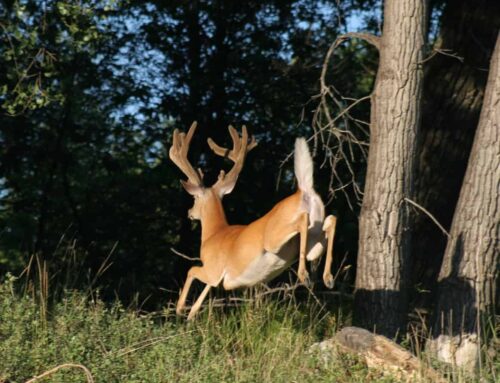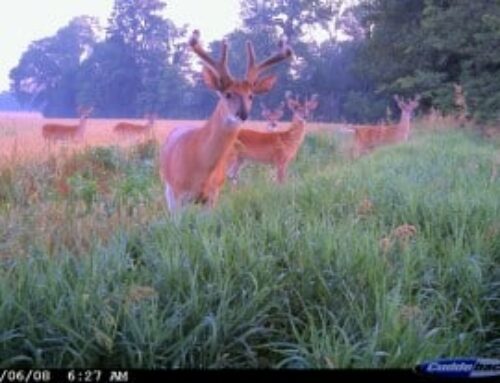Forget the rut for now. The first days of your archery season in September or October can be a great time to whack a 10-pointer. The bucks are relatively docile and locked into their summer/early fall bed-to-feed patterns. So long as you don’t press them too hard, they’ll keep moving reasonably well at dawn and dusk. Tweak these setups to your land and tag out early.
The Choke Point
One September I hunted in sprawling alfalfa and corn country where you could see deer coming and going for miles. The only way to have a fighting chance with a bow in a big spot like that is to narrow the country down, way down.
During the middle of the day when the deer were inactive, I looked around for two hours and sized things up. Then I tucked a tree stand back in a shady edge where a tractor path crossed a strip of weeds. There was a thin strip of timber upwind of my stand, and another strip 40 yards east of the farm road. I figured any deer that came off the alfalfa the next morning would gravitate to this choke point. If a shooter walked through there…
An hour after dawn, I glassed two racks a mile away. It took them a while to get to me. Around eight o’clock, the bucks hit the dirt road and walked down it. They turned, took the weed funnel between the tree strips and walked broadside 30 yards below. I nailed the 8-pointer in the lead.
To me, bowhunting for whitetails is all about edges and choke points, or spots where old roads, strips of trees, pockets of weeds and other terrains and covers converge. The more of these “fringe areas” the better. Deer walk the edges year-round, and they especially use them when traveling to and from food sources in archery season. Set up where three or four strips and edges meet, and you’re apt to smoke a good buck like I did that morning.
Corner a Buck
Anytime I hunt a crop field I look for the nearest fence and walk it out to the corners. You can never scout too much, just be low-impact about it. Inevitably I find a corner with a lot of deer sign—tracks, a trail and maybe tufts of hair on the barbed-wire where deer are jumping it.
A fence corner is a natural place for deer to travel, and a natural spot for you to set up. A prime corner to hunt will have lots of brushy cover, and at least one stout tree nearby for a stand. But if the sign is there and cover is sparse, I’ll play the wind and set up a small brush blind 35 yards or so off the corner. On the ground makes it tougher…and all the sweeter if you stick your buck in the corner.







All good points and advice. So true. Right now, deer are walking casually through 1 foot of lush alfalfa to check out some volunteer wheat and barley in the stubble fields too. Keep that in mind. Most of the young bucks are still in bachelor groups. The biggest, oldest bucks keep their distance and own routes from them and will usually have a “wannabe” tailing them. Watched that just two days ago actually. Oh…and watch out for the porcupines…apparently when the males are wanting attention from an uninterested female, they will actually “chase” deer away from her…even when it’s on the only path to your tree stand. Who knew the sounds porcupines make? Crazy trolls.
I’ll be hunting a choke point and/or a corner this week…depending on the wind. Thanks Mike.